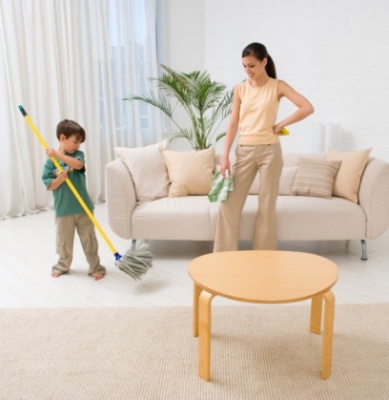Cleaning Tips for Allergy and Asthma Sufferers
 These simple steps may reduce your risk of developing allergy and asthma symptoms when you clean:
These simple steps may reduce your risk of developing allergy and asthma symptoms when you clean:
Kitchen
Use an exhaust fan on a regular basis to remove cooking fumes and reduce moisture. Place garbage in a can with an insect-proof lid and empty trash daily. Store food—including pet food—in sealed containers, and discard moldy or out-of-date items.
Each week, mop the floor and wipe cabinets, backsplashes and appliances. Clean cabinets and countertops with detergent and water, and check for plumbing leaks. Wipe up moisture in the refrigerator to avoid mold growth.
Empty and clean drip pans and clean or replace moldy rubber seals around doors. Wash the dish rack, and wipe the light switch plates, phone and inside of the garbage can.
Seasonally, empty and scrub down the inside of the refrigerator and the utensil drawers. Scrub down the cupboard exteriors and clean the stove-hood filter.
Living Areas
Encase pillows, mattresses and box springs in dust-mite-proof covers. Wash sheets, pillowcases and blankets weekly in 130o F water. Remove, wash or cover comforters.
Clean carpeting weekly with a vacuum cleaner that has a small-particle or HEPA filter. Wash area rugs and floor mats, and mop hard surface flooring weekly. Use curtains made of cotton or synthetic fabric. Wash seasonally.
Keep windows closed and use air conditioning during pollen season. Clean mold and condensation from window frames and sills with a solution of chlorine bleach (3/4 cup chlorine bleach to 1 gallon of water). Always wear a protective mask when cleaning mold.
Remove anything that collects dust, such as knickknacks and books. Store toys, games and stuffed animals in plastic bins. Keep pets out of the bedroom. Bathing animals twice a month may reduce allergens.
Hot, humid houses are breeding grounds for dust mites and mold. Maintain temperature at 70o F and relative humidity at 30 to 50%. Clean or replace small-particle filters in central heating and cooling systems and in-room air conditioners at least once a month.
Control cockroaches and mice with traps from the hardware store, or hire a professional exterminator. To prevent re-infestation, seal cracks or other entryways.
Bathroom
An exhaust fan can reduce moisture while taking baths or showers. Remove carpeting if possible and use wood or linoleum flooring. Use washable rugs. Remove wallpaper and install tile, or paint walls with mold-resistant enamel paint.
Towel-dry the tub and enclosure after use. Scrub mold from tub and faucets. Clean or replace moldy shower curtains and bathmats. Quickly repair any leaks.
Basement
Basements can be a challenge. Not only can they be damp and dusty, but they can also harbor rodents or mold. Always wear gloves and a mask when cleaning a basement that has either of these problems. If vacuuming, empty the bag outside, while still wearing a mask, and place it directly into a trash bag, tie and put in the trash container immediately.
Remove moldy or water-damaged carpeting. If possible, use cement or linoleum flooring. If that isn’t an option, use low-pile instead of high-pile carpeting and use a vacuum cleaner that has a small-particle or HEPA filter weekly. Install plastic sheeting (vapor barrier) under carpeting to prevent moisture seepage.
Check for and repair any sources of leaks or water damage. A dehumidifier can reduce dampness – clean it once a week. Use an exhaust fan to vent moisture from a clothes dryer outside.
Mildew
Wash concrete floors and walls with a solution of bleach and water (see above). Allow the solution to sit for five minutes, then rinse and dry. Always wear rubber gloves when working with bleach or vinegar solutions.
If you have a section of carpet with mold or mildew, clean the back of the carpet with one part hydrogen peroxide to five parts water. If possible, remove the carpet and place it outside in the sun to dry. If not, prop the section up and use a fan to dry the area.
If you have mold or mildew on basement walls, use one of the solutions listed below to clean, but you must also remove the moisture from the area. Use a dehumidifier or fans to circulate the air, and open windows if possible.
Cleaning Option 1: Straight vinegar sprayed on the walls. Don’t rinse, just air dry.
Cleaning Option 2: Mix 2 cups vinegar, 2 cups very hot water, 1/2 cup salt and 2 cups borax. Apply solution to area and allow it to sit for 30 minutes. Apply the solution again, scrubbing with a soft bristled brush and rinse well with plain water.
Find out more about rhinitis.
The AAAAI's Find an Allergist / Immunologist service is a trusted resource to help you find a specialist close to home.
12/11/2023